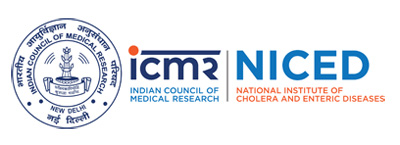ICMR-National Institute of Cholera and Enteric Diseases
आई सी एम आर - राष्ट्रीय कॉलरा और आंत्र रोग संस्थान
Department of Health Research, Ministry of Health and Family Welfare, Government of India
स्वास्थ्य अनुसंधान विभाग, स्वास्थ्य और परिवार कल्याण मंत्रालय, भारत सरकार
WHO Collaborating Centre For Research and Training On Diarrhoeal Diseases
Immunology
Immunology

The major goal of the Division of Immunology has been to study mucosal immune regulation by two proteins: porin, the major outer membrane protein of the Gram negative bacteria, Shigella dysenteriae type 1, and hemolysin (HlyA), a pore-forming toxin released by Vibrio cholerae. Our research interest covers three main aspects of mucosal immunity: Toll-like receptors (TLR)-mediated recognition of the molecule by immune cells, triggering of downstream signaling pathway upon recognition, and finally, the immune outcome elicited by the signal transduction.
Highlights of recent work include:
- Porin was purified to homogeneity as an oligomer of 78 kDa, with the fully dissociated monomer of 38 kDa.. The protein was found to be cell-surface exposed and antigenically related among the four Shigella spp.
- This protein was recognized by combination of two TLRs, TLR2 and TLR6, which triggered the downstream signaling pathway through MyD88 and TRAF6, ultimately leading to activation of the proinflammatory transcription factor, NF-kB.
- Expression of type 1 cytokines and chemokines by the protein suggested type 1 polarization of APCs; macrophages and dendritic cells, which eventually activated naïve CD4+ T cells and triggered their differentiation to Th1 phenotype.
- The B cell subsets, B-1a, B-1b and B-2, responded to porin by expressing IgM, IgG2a and IgA, thereby triggering an effective mucosal immune response.
- In association with Dr. Kalyan K. Banerjee, Division of Biochemistry, our laboratory has shown differential regulation of peritoneal macrophages and B-1 cell populations by monomeric and oligomeric forms of HlyA. HlyA oligomer proliferated and activated murine B-1a cells, subsequently leading to IgM and IgA expression that could be augmented by IL-5 and IL-6. However, the HlyA monomer was found to guide majority of the cells to apoptosis, which was caspase-9 and caspase-3 dependent. This study shows for the first time that two forms of the same protein could drive the host immune cell to two different outcomes, one of death and the other towards activation. In another study, it was examined if resistance of a protein to proteolytic processing affects the expression of the costimulatory molecules, CD80 and CD86 on macrophages, when exposed to the same antigen. Time-dependent and selective expression of CD80 and CD86 by macrophages showed that proteolytic processing of the dimorphic protein plays a decisive role in expression of the costimulatory molecules.
